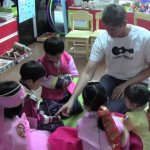Many of us remember playing elimination games like Musical Chairs and Simon Says when we were young. These are games where you start with a group, and each round, one or more players is “out” and eliminated from the game. As you get closer and closer to the end of the game, the tension builds, and it can be a lot of fun (and beneficial for young learners).
However, for some very young learners, these kinds of elimination games can be very upsetting. It’s not so much that all of the kids want to win, but they want to keep playing! They don’t want to be removed from the group, and that’s perfectly understandable.
There are a few ways to handle this.
1) Demonstrate how to “lose” positively
If you do play a game where participants get eliminated, be sure, as the leader, to eliminate yourself first. When you are “out” have fun with it! Say in a fun, exaggerated way, “Oh no!” and laugh. You’re showing the students that this game is just for fun. Young learners will see you having fun with it, and so when they are “out”, they won’t take it too hard.
2) Make getting “out” fun
When a child does get eliminated in the game, give her a high five, let her sit in a special chair, make a silly noise, maybe even give her a sticker. When you make getting eliminated from the game fun, everyone has a good time. In the video below, note how much fun the kids who are removed from the game are having.
3) Eliminate the elimination
For very young learners, often there is no need to have a winner or any sense of competition to make the activity fun. In trying to make games fun and interesting for young learners, we often add an element of competition when no competition is needed. You can play the same games without anyone ever being “out”. This is especially true for kindergarten and preschool students who usually enjoy playing the game regardless of whether anybody wins or loses. For example, you don’t have to remove a chair each round when you play Musical Chairs. Try playing non-competitive Musical Chairs:
In this version of Musical Chairs, no students are ever “out”. Set out enough chairs for each student in the class. Under each chair, place a picture card of some vocabulary you are practicing. As the music plays, students march around the chairs, singing along. When the teacher stops the music, everyone sits down. The teacher asks each of the students one by one, “What’s under your chair?” The students take the picture cards from under their chairs and say, “It’s a dog/cat/pencil/hat/etc.,” while doing the gesture for that word. Place the cards back under the chairs and start the music again. Try to stop the music so that each player gets to sit in each chair.
This kind of thinking extends to all kinds of activities with young learners. For example, if you play BINGO with younger learners, you can celebrate each time someone gets BINGO, and then have a big celebration when everyone has gotten BINGO. You celebrate getting BINGO rather than just celebrating the first person to get BINGO. For pre-elementary school students, that element of competition just isn’t necessary.
Keeping these ideas in mind when doing activities where participants are traditionally eliminated can save some hurt feelings and help keep classes fun and positive. We’d love to hear your ideas, too!


